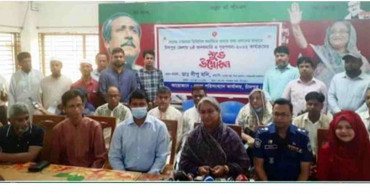Population Census
For the first time, Bangladesh has more women than men
Bangladesh has witnessed a major demographic shift since record-keeping began in the country, with females outnumbering males for the first time in a population census.
Of a total population of around 16.5 crore recorded in the latest census, 81,712,824 are males and 83,347,206 females -- which means that for every 100 females, there are 99 males. The transgender count, on the other hand, is 12,629.
This has happened for the first time in the history of independent Bangladesh and that too under a female Prime Minister who has undertaken a slew of measures for gender equality and women empowerment since coming to power.
The provisional data of the '6th Population and Housing Census 2022' was revealed by the Bangladesh Bureau of Statistics (BBS) at a presser at Bangabandhu International Conference Center in Dhaka on Wednesday.
The Census was supposed to end on June 21 but due to floods in the north-eastern districts, it continued till June 28.
Read: Population Census gives right picture of country: Dipu
Except Muslims, the population of other religious communities has decreased in the country, according to the preliminary report of the Census that has pegged the country's exact population figure at 165,158,616.
While Muslims constitute 91% of the population, Hindus are 7.95% -- a decrease from the 2011 census when it was pegged at 8.54%. The Buddhist population has also decreased to 0.61% in 2022 from 0.62% in 2011.
Jatiya Sangsad's speaker Shirin Sharmin Chowdhury, Planning Minister MA Mannan, State Minister for Public Administration Farhad Hossain and State Minister for Planning Shamsul Alam were present on the occasion.
As per the report, the average annual population growth rate in Bangladesh is 1.22%. The average population growth rate in the 2011 census was 1.37. The population density has increased to 1,119 people. In the last census, it was 976.
The signature (people able to write) rate population has increased to 74.66% from the previous census figure of 51.77%.
Similarly, 55.89% of mobile phone users are aged over five years. The number of internet users is 30.68% of the total population.
Now, the total number of restaurants in the country is 4.10 crore. In the last census, it was 3.21 crore. The number of families -- with four members -- is now 4.10 crore.
3 years ago
Population Census gives right picture of country: Dipu
Population census plays an important role in the country’s development planning providing a right picture of the realities, said Education Minister Dipu Moni on Wednesday.
“Through the population census, the accurate rate of education will be known and we will be able to get a true picture of the country,” she said while inaugurating the 6th population and housing census from her Chandpur residence on Wednesday.
Read: Don't react to provocations on social media: Dipu Moni
The 6th digital population and housing census in Bangladesh began on Wednesday across the country.
Bangladesh Bureau of Statistics (BBS) has launched the population census past midnight Tuesday.
How many people remain illiterate, how many people are educated and their financial-social status will be known from the census, which will help to make plans for different activities, she said.
This is the first time in Bangladesh that the government has conducted the population census digitally.
Earlier on Tuesday, State Minister for Planning Shamsul Alam said around 3.70 lakh enumerators will collect the data countrywide from June 15 to 21, for planned development of the country.
Read: More institutions to come under MPO: Dipu Moni
The BBS has completed a trial of information collection process for the enumerators in several phases and constructed a census area for each 100 households.
The main objectives of census population and housing are- calculating the total population by counting the members of each house and families, determining the number of houses / dwellings in the country; collection of data for adoption of overall development plan, Provide information for determining constituencies in local and national elections; and provide information aimed at ensuring equitable distribution of national resources, said BBS.
The first population census in Bangladesh was conducted in 1974. Subsequently, the population and housing censuses were held again in 1981, 1991, 2001, and 2011.
3 years ago


